Internationale Laborwoche 2020
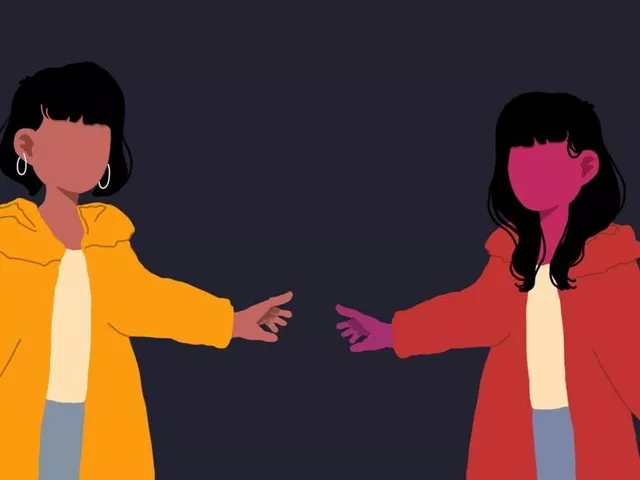
Programm
Hier findet ihr in Kürze das Programm zur Laborwoche 2020.






Blending and Responding shapes: Hands-on Variable Fonts
Der Workshop behandelt die elementaren Basics der Schriftgestaltung (Theorie und Software) und setzt einen Fokus auf Vektoren und Interpolation um schlussendlich einen kleinen Variable Font zu kreieren und in CSS zu animieren.
Jakob Runge von TypeMates


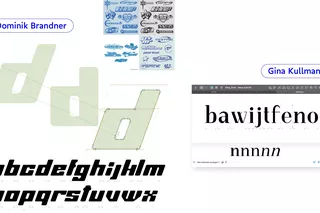





Chatterbox – Building unusual chat interfaces
We will use a simple web server (supplied by the lecturers) to play around with communication over the web. The result will be some kind of interface to exchange signals with one or more other participants.
These signals could be text but also any other bit of information like emojis, sound, graphical shapes, colors, … . There is only one restriction: build anything but a normal text-based chat client!
Hartmut Bohnacker, Vanessa Stöckel








Chindogu … the art of the almost useless
To design usefull things is easy. To design useless things is even easier. To design things though which equally overcome the realm of the usefull and the useless alike rising up to the olymp of the almost useless is the supreme discipline.
»Chindogu« is the Japanese word describing the art of designing almost useful things which solve the small problems of everyday life – to finally collapse all along the line. ”Chindogus can give live a new direction. The change one’s perception.«, says Kenij Kawakami, the president of the International Chindōgu Society. Chindogus challenge the principles of perfection and efficiancy which mark the thinking of industrially shaped societies.
Prof. Florian Pfeffer
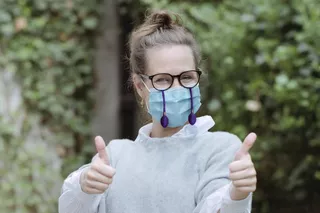





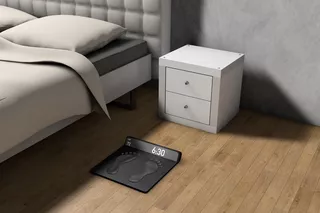
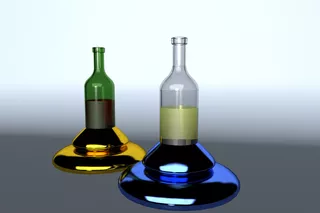
Coded Biophilia
Coded Biophilia is a workshop designed to learn basics of soft wearables and the exploration of biological textiles.
During the workshop, students will explore the potential of bacterial cellulose for textile futures in terms of growing living materials and creating speculative scenarios for second skins, sensors, and adaptive responsive structures.
Learning new methods of making sensory surfaces for wearables and to envision how biotechnology and new materials will shape our environment. At the end of the workshop, students will be able to identify state-of-the-art soft wearable and bio-textiles applications.
Giulia Tomasello



Comiczeichenen für Einsteiger*innen
In the workshop „Comic Drawing for Beginners“ we will deal with the idea generation, conception and gradual elaboration of a short comic of 4 – 6 pages. The focus is on developing a comprehensible narrative structure and finding your own visual voice.
Julia Bernhard





Design and the transition to a circular economy
Design will play a key role in the transition to a circular economy (CE). Too often we design products with little regard for what happens when we no longer want them. But waste is design gone wrong!
This course will strengthen your skills as a designer by tackling the transition from our linear „take-make-waste“ economy to a circular economy. In a circular economy products loop back into the production system through repair, refurbishment, remanufacturing and eventually, recycling. By doing this we extend their useful life and design out waste.
We have a Massive Open Online Course (MOOC) available to use for free. For the 3 days of the seminar week we will use the following sessions in the MOOC:
Day 1 (Episode 1): What is the circular economy?
How can the circular economy provide solutions to the challenges our current, linear economy brings? We explore the roots of the circular economy together with experts in the fields of industrial ecology, cradle to cradle and biomimicry.
Day 1 (Episode 2): Business value in a circular economy
Through closed loop supply chains and reversed logistics, new opportunities for business are created. This episode explores value creation and new business models in a circular economy.
Day 2 (Episode 3): Longer lasting products
The smaller the loop, the greater the profitability of the system. We look at product life extension through the eyes of designers and entrepreneurs. Join us in our repair café!
Day 3 (Episode 6): Thinking in systems
The shift from linear to circular should not be underestimated. This episode will discuss the extent and duration of the transition. It will also ask, is the circular economy really sustainable?
Dr. David Peck





»Das habe ich gar nicht gesehen« Aktives Sehen – Filmanalyse
# Zuerst werden wir unser Sehen mit vielen praktischen Übungen sensibilisieren. (u.a. mit Fotoaufgaben,…)
# Danach werden wir die filmische Einstellungen und Kamerapositonen als Grundlagen für eine Filmanalyse kennen lernen.
# Durch kurze Videos und Filmausschnitte werden wir das erworbene Wissen aktiv anwenden und dadurch unser Sehen erweitern.
# Es könnten Infoplakate/formen als Kursdoku entstehen.
Dipl.-Designer Rasih Bayölken
Fluid Expressions
As designed things are increasingly ‘made’ through networked computation as well as physical materials, meaning that they become “fluid assemblages” that are inherently changeable rather than stable objects, their forms still typically mimic earlier types of things.
What would it mean to more ‘honestly’ and ‘transparently’ bring to presence what these connected things are and do? What would be a more appropriate aesthetic expression for things that are fluid assemblages? In this workshop, we will explore these questions through investigating what certain connected things actually are and do, and then reimagining them in alternative ways that better express their complex and fluid character.
Dr. Heather Wiltse and Dr. Marije de Haas




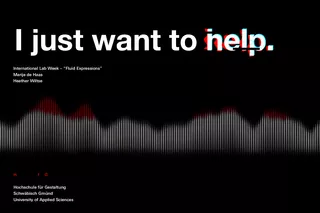
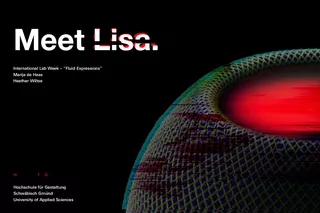

Foodture – Design and the future of food
Der Frage „Wie ernähren wir uns in Zukunft?“, welchen Einfluss wir Gestalter darauf haben und welche Möglichkeiten sich dort für Gestalter ergeben, dessen widmet sich unser Workshop.
Zweieinhalb Millionen Jahre lang ernährten unsere Vorfahren von Pflanzen und Tieren, die ohne menschliche Eingriffe lebten und sich vermehrten. Heute kommt unser Essen mit nur einem Klick bis vor unsere Haustüre.
Die steigende Weltbevölkerung verschärft zudem das Verlangen nach einer gerechteren Lebensmittelverteilung. Zusätzliche Faktoren wie Klimawandel und Tier-Ethik führen zu Trends wie Veganismus/Vegetarismus in Industrienationen, wogegen einst vegetarische Länder wie Indien vermehrt zu Fleisch greifen.
Denn zum einen gehen die Trends zu einer funktionalen Ernährung (Bsp. meal-replacement shakes, personalized nutrition, etc.) zum anderen steuern wir auf eine erlebnisorientierte Ernährung (Bsp. Krimidinner, Slow Food, etc.) zu.
In “Foodture – wie könnte die Zukunft rund um unsere Esskultur aussehen?” unternehmen die Studenten eine Zeitreise durch die wichtigsten Meilensteine in der menschlichen Ernährungsgeschichte und sie lernen die wichtigsten Ernährungstrends der heutigen und vergangenen Zeit kennen, um daraus eigene Szenarien für die Zukunft abzuleiten und dafür zugeschnittene Produkte/Dienstleistungen zu gestalten.
Paul Rees, Maurizio Blötscher


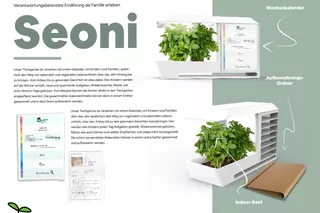



Fun is fundamental
The goal of the workshop was not to deliver a solution but to train our design process. We were not concerned with aesthetics but, rather, with content and the flow of our thoughts. Our wish was to achieve the flow defined by Mihály Csíkszentmihályi.
The students were given tasks one by one, meaning that they had no idea what was coming next. The first task was to collect something from physical (urban) space. They were quite pleased to be away from the computer screen for a little while … They were then tasked with analysing the item they had chosen and writing a sentence about its basic principle. This sentence became our new beginning. They then had to find a photo that they associated with the meaning of the sentence.
Now the proper fun began. They were asked to arrange the photos one after another so that each new photo had an associative connection with the previous one. That connection might be merely visual or be more profound in nature. They had to arrange at least ten photos, after which they could stop whenever they wanted to. It was quite interesting to see that three of the students stopped when they had reached an association with a sentence from phase two. During the conversation, we were able (without any additional effort) to write down our second sentence that described the last photo. This sentence then led to a diagram, which was our concluding task.
Primož Fijavž






Getting comfortable with Design Research
Understanding the people we design for is essential in order to create solutions that are relevant and solve real problems that people have. To gain this understanding we have to immerse ourselves in the lives of people we want to help.
This workshop is about helping you to become confident with planning, preparing, carrying out, and synthesising your user research. You will gain a good understanding of what design research is about, and get introduced to some useful research methods to use in your own future projects. You will also work on a case in small groups to practice a selection of these methods.
Jenni Toriseva & Joanna Pruchnicka
goEducation – Entrepreneurial Tools
Du willst dein Projekt auf die nächste Ebene bringen, willst herausfinden, ob aus deiner Idee auch ein stabiles und erfolgreiches Geschäftsmodell werden kann? Willst Einblick wie echtes Business funktioniert? Bei Thomas Schönweitz hast Du die Möglichkeit Stakeholder Mapping, Research-Technik, Werteversprechen und Business Model Canvas anhand von konkreten Fallbeispielen nachzuvollziehen und zu entwickeln. Dazu kommt ein Einblick in erste Finanzmodelle um herauszufinden ob sich deine Ideen auch wirklich rechnen, und was du tun kannst damit sie skalierbar werden.
„Der Workshop war super informativ. Ich habe viele Methoden und Tools gelernt, die ich auch perfekt in zukünftigen Projekten anwenden kann.„ Mona Freudenberger, Teilnehmerin goHfG WS21
„Der Workshop gibt mir eine super Basis um jetzt richtig durchzustarten. Kann ich jedem nur empfehlen.“ Alina Gaides, Teilnehmerin goHfG WS21 und Gewinnerin des goHfG Award
Neben der Gestaltung von Geschäftsmodellen sind auch gute Texte für Kommunikation und Marketing (Presse, Portfolios und Suchmaschinen) ausschlaggebend. Bei Carmen Fischer lernst Du daher wie schnell ein guter Text entsteht. 10 Tipps für die Überarbeitung eigener Texte kannst Du dann am letzten Tag gleich umsetzen und Dich mit 2 Din A4 Seiten um den goAward bewerben.
Zusätzlich zu den 3 Tagen goEducation Entrepreneurial Tools bieten wir für alle, die noch tiefer einsteigen wollen, mit dem folgenden goHfG advanced workshop volle Betreuung und individuelles Feedback zu Deinem Projekt und Pitch.
Thomas Schönweitz / Carmen Fischer





Information visualization
The course will start with a general lecture on the principles of information design from a data- and content-driven perspective and an introduction to how human perception affects design decisions. An introduction to a selection of available tools for information design will also be given.
The participants will complete a hands-on introduction to creating statistical maps and visualizations with QGIS, an open-source GIS program suite. Based on it, each student will do a small visualization assignment.
Jonatan Hilden



Masse statt Klasse – Viel Übung hilft viel….
Sketching ist eines der einfachsten, schnellsten und effektivsten Kreativ.- bzw. Kommunikationstools welches Gestaltern zur Verfügung steht. Über einen Skizzenprozess können Ideen gesammelt und dokumentiert werden, sie können verändert und über Varianten weiterentwickelt werden, sie können für interne und externe Workshops und Entscheidungen genutzt werden und sie helfen Teams sich zu organisieren und zu focusieren. In einer Auftraggeber Dienstleisterbeziehung kann selbstverständliches Skizzieren Missverständnisse vermeiden und Abstimmungen beschleunigen.
Sketching ist ein erlernbarer Prozess der durch permanentes Wiederholen und selbstverständliches Anwenden zu einem wertvollen Tool für Produktdesigner werden kann. Gefühl für Perspektive, Dreidimensionalität und Proportion werden geschärft und kommen in einer sehr frühen Phase des Projekts zu Anwendung. Studierende neigen off dazu zu selten und mit Focus auf ein „schönes Bild“ zu skizzieren oder haben Hemmungen ihre Skizzen zu zeigen, weil sie Sorge haben sie sind nicht gut genug.
Der Kurs basiert auf 4 Eintagesthemen mit einfacher Aufgabenstellung (Pfeffermühle, Seifenspender, Toaster…) zu denen die Studenten 8 Stunden möglichst konzentriert Entwürfe skizzieren sollen. Parallel dazu können sie dem Kurzsleiter (online oder vor Ort per Kamera und Beamer) beim Skizzieren zusehen. So entsteht eine Mischung aus Zusehen und Selbermachen mit gleichzeitiger Forderung Sketching 8 Stunden täglich zu praktizieren und zu üben. Die Studierenden sehen beim Kursleiter und den Mitstudierenden wie Skizzen entstehen, verworfen werden, sich verändern, verbessern und in grosser Menge schnell entstehen können.
Andreas Hess
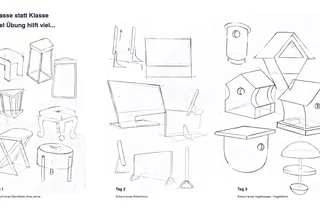








Moving Food: Food Transport / Food Trucks
The workshop traces how contemporary food is moved and transported, through the design of a mobile food concept. We look at the complex and cross-cultural origins and sourcing of food and then develop creative, innovative means of exposing these processes and problems to the public. We will develop concepts, communications media, physical designs and sustainability models, examining what is gained and what is lost in trying to create balances, careful and respectful cross-cultural, intersectional and ecologically-minded consumption practices for future communities. Food trucks are part of the history of labour, originally responding to urban metabolic needs of industrial modernity. Also, the pandemic has brought the topic of delivery, food mobility and resources to the fore, giving us a rich, new area for thinking and acting through art and design practices.
Abbéy Odunlami & Jamie Allen
My view
In dem Workshop MY VIEW werden Bild-Erfassungen (Fotografieren / Filmen etc.) mit gängigen und zukünftigen Tools konzipiert:
- Visionen für die Erstellung UND Bearbeitung von eigenen „Aufnahmen“ (reale Fotos und Videos sowie eine Mischung aus realer und virtueller Welt).
- Welche Technologien werden eingesetzt oder „neu“ angedacht (Smartphone, Kamera, Drohne, Sensorik, visionäre Ansätze…)?
- Wie wird das Bild festgehalten und auch direkt bearbeitet(Interaktions-Konzepte wie Eye-Tracking, Gestensteuerung, Sprachsteuerung, Haptik…)?
- Folgt eine Bild-Erfassung dem eigenen Blick (MY VIEW) oder kann sie auch von außen (z.B. weiteren Personen) gesteuert werden?
- Sind Standard-Produkte zum Fotografieren wie gängige Smartphones und Kameras wirklich zeitgemäß oder können sie durch andere physische und virtuelle Produkte ergänzt oder sogar ersetzt werden?
M.A. Juliette Fitz, Prof. Sebastian Stroschein





«Raus aus dem Schema F*» – Entwicklung und Gestaltung von innovativen Konzepten im Kontext Gender und Identität
Everyone is confronted with gender discrimination, through socialized role models and stereotypes. The discrepancy between legally defined and lived equality is a blind spot, a grey area, which has a high social relevance. During the lab week we will question gender concepts, role models and stereotypes. Using specific design methods (e.g. narrative interview, cultural probes, nethnography, empathy experience, etc.) we find out on which levels of everyday life gender-specific connotations, associations and reactions take place. The focus of the lab week is the insight-driven and explorative approach to design as well as the transfer into the design process. We embark on a short journey that teases out innovative ideas and lies outside the usual, obvious comfort zone.
Henriette-Friederike Herm
Assistant professor and student assistant
We are losing our death literacy: we are losing know-how and skills on how to face and support people in the end of life, albeit a close loved one or somebody in the community.
The confrontation with death and dying seems to be disappearing from our daily life. Hospitals, hospices and graveyards are more and more outside the cities. Also, our (secular) society loses the social rituals, customs and practices surrounding the end of life. The end of life becomes more and more a medical event- outsourced to professionals – rather than a deeply shared social experience.
In this workshop we will explore how we could increase our death literacy through design. An installation in public space? A new public campaign? A new social ritual?
Marieke Sonneveld and Erika Hajdu





Informations-Bibliothek HfG
The Media Lab, the Zapp, the workshops, the DP Lab – the HfG offers 1000 opportunities to give free reign to creativity and to try things out. But where do you find this info.
For this we need your knowledge and not-knowledge! Together with you we want to make the HfG experienceable by students for students. We want to create something that provides students with all the necessary information, guidelines and templates. So you and future students can use the full offer of the HfG for you and your projects.
Florian Geiselhart
Urban Spaces – Inside Out
The students have to develop, design and realize a concept for „Urban Spaces – Inside Out“.
The theme includes the fields of design, architecture and urbanism. What is inside, what is outside? What does people need in cities? Research and realization shall be combined. Aspects like sustainability, different cultures, migration should be considered and implented into the project.
Ponam Choudhry
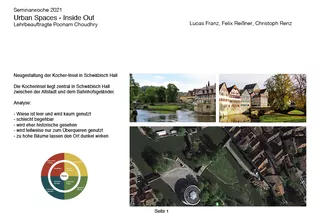
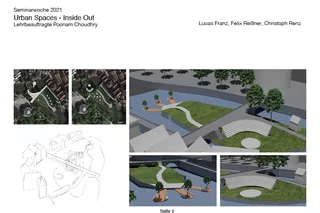









User-Empowering Design
Workshop’s Subject:
Promoting Life Quality & Equality Through Design – Ergonomic Design and Inclusive Design as a tool for user empowerment.
Ergonomic Design and Inclusive Design, as tangential approaches that implement ethics, social responsibility and creative empathy in industrial design, in order to promote the user’s health and to realize its full potential.
Workshop’s Objective:
To provide the students knowledge, tools and skills to design in such a way that the product will take into account the abilities and the limitations of the human body and will best adapt to the capabilities and the needs of each user. The product will improve the user’s performance, and will enable him effective, convenient, independent & safe usage, without any health damage (immediate or cumulative). All this – while preserving the values of equality and respect to the user.
Workshop’s Nature:
The workshop is mainly theoretical. It is composed of segments – each fragment consists of a frontal lesson (combining various active-teaching techniques) and practice for applying the knowledge studied in the lesson. This way, the student experiences a structured series of knowledge-training clusters that lead him, while accumulating knowledge and increasing level of difficulty, into the final exercise. In this exercise, the student will be required to implement all the tools he acquired during the learning process, in order to provide a design solution to the problem, while empowering the user’s capabilities.
Workshop’s Content:
Examples of lessons“ topics – Anthropometrics; Biomechanics; Strategies to prevent musculoskeletal overuse disorders that may be caused to the user by the product; Ergonomic Design & Inclusive Design Guidelines; Ergonomic aspects of task analysis techniques; Mental Model; etc.
Eran Franco

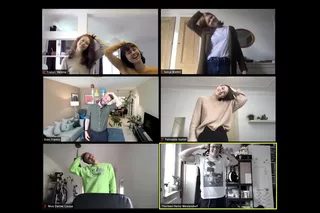
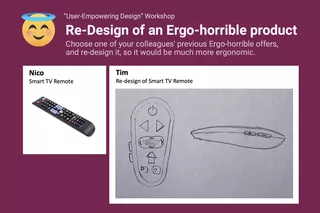
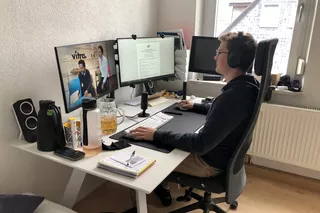


Well-being for urban birds
Current built environmental conditions around the world are the result of many things that went wrong over the last several decades. Among which is, the obsessive focus on so-called ‘Human Centric Design’. In the process, neglecting not only socially and economically marginalized communities around the world but also largely denying the existence of rest of the living beings in urban context.
Particularly the urban built environment has been harsh and often disregarded any significant considerations for the needs of living beings such as birds.
In this workshop we will focus on creating ‘Well Being for Urban Birds’. By understanding the ‘Bird-Lifecycle’ and taking all their needs into consideration to create poetic response within urban condition. It is in our interest to design for well-being of birds as they increase human happiness.
It is high time to envision and create ‘Design for all Sentient Beings’, meaning cohesive design for all living beings which are able to experience feelings.
Satyendra Pakhalé
Ansprechpersonen
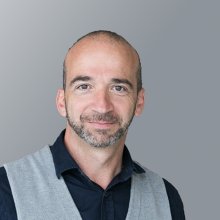
Prof. Matthias Held
Prorektor Forschung und Transfer
Produktgestaltung
Grundlagen der Gestaltung
Ansprechpartner für Fragen im Zusammenhang mit sexueller Belästigung und für Antidiskriminierung
